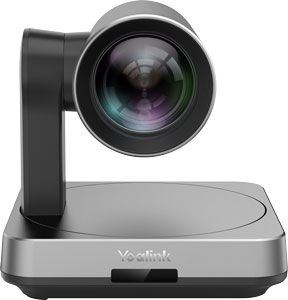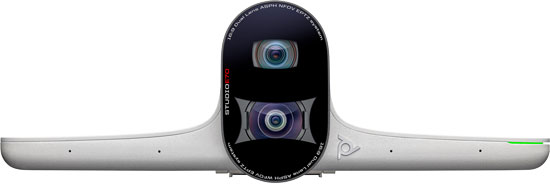Wide-angle, ultra-wide, narrow? Camera lenses come in many varieties. It can be hard to figure out what to use for video conferencing. That’s where this blog comes in.
We’re going to explain to you what viewing angle fits what situation, so you can get the camera(s) that will optimize your video conferencing experience. Let’s start with some things to keep in mind when shopping for a video conferencing camera.

Video Conferencing Camera Viewing Angle Considerations
Here are some of the basic things to consider when looking for a video conferencing camera:
- Room Size and Desk Shape
- How Close People Are to the Camera
- Technologies to Compensate for Viewing Angles
- Multi-Camera Video Conferencing Systems
- Dual Lens Video Conferencing Cameras
Room Size and Desk Shape
Is the conference room small or large? Is it wide or narrow? What shape is the conference desk?
These are the basic questions to ask when shopping for a video conferencing camera. If the room is smaller, people will necessarily be closer to the camera, which means you’ll need a wider-angle lens, or else the camera won’t pick them up. So for huddle rooms and small conference rooms, look for a wide-angle video conferencing camera. Similarly, if the conference table is broad, you’ll need a wide-angle camera to capture everyone along the horizontal axis.
If people are farther away or the table is narrow, then you’ll need a narrower-angle lens. The lens then has the reach to display faces in good detail without needing to worry about picking up people on the edges.
If the conference room is large, you’ll need a camera with zoom. There are two types of camera zoom: optical and digital (or electronic).
- Optical zoom means, basically, the lens itself can focus closer. You’ll see it referred to as lossless zoom, too, because the camera is using all the pixels available on its sensor while getting a closer image. All else being equal, optical zoom always gives you better picture quality than digital zoom.
- Digital zoom or electronic zoom means the camera achieves the effect of focusing closer by cropping and enlarging the image. Digital zoom is lossy because the camera is taking a portion of the picture and using only that, so it’s not using all the pixels available on the sensor. One way that cameras compensate for this is to use a larger camera sensor than is strictly needed, for example, using a 4K Ultra HD sensor for 1080p Full HD video conferencing. The pixel overhead reduces the impact of digital zoom.
Along with zoom, you’ll also want pan and tilt: a PTZ camera. Pan simply means that the camera can move left to right; tilt means it can move up and down. A PTZ camera like the one found in the Yealink UVC84-BYOD Kit for Large Rooms offers full PTZ capabilities, including 12x lossless optical zoom.
You might come across the term electronic PTZ (ePTZ) or digital PTZ. This is the equivalent of digital zoom: the camera is achieving the effect of PTZ by cropping the image.

How Close People Are to the Camera
Related to room size is the question of how close people will be to the camera. The closer people are, the wider the camera viewing angle has to be. Close means wide. The new Poly Studio R30 is a good example of a huddle room camera with a wide-angle lens. This all-in-one video bar has a lens with a 120° field of view, which is very wide.
One problem that might arise if people are too close to the camera is distortion. Lenses distort shapes on the edges. This becomes particularly acute with wide-angle lenses. Think of the ultra-wide fisheye lens used in 90’s music videos. Many cameras now provide some sort of distortion compensation, but you can only fight the science of optics so much.
There are two ways to deal with distortion on the edges. First, get a camera that has automatic group framing and speaker tracking. Second, establish a multi-camera system.
Technologies to Compensate for Viewing Angles
Let’s face it, you’re almost never going to be able to get the perfect shot. To solve this problem, camera manufacturers have developed automatic group framing and speaker tracking.
Group framing means the camera automatically crops the image to reduce wasted space. The camera senses which objects in the picture field are people and then crops accordingly. It does this dynamically. This makes a huge difference for the people on the far end of the conversation looking at a display. Rather than have the display be filled with empty table space and walls, they get to see just the people in the conversation.
Speaker tracking is similar to group framing. Rather than framing the whole group, however, speaker tracking framing the active speaker. The camera uses a beamforming microphone array to pinpoint where speech is coming from, then automatically homes in on that person.
Both group framing and speaker tracking allow the camera to compensate for the camera’s natural viewing angles.

Multi-camera Video Conferencing Systems
For large and extra-large conference rooms, you’ll likely want a multi-camera setup. By using more than one camera, you ensure that all side of the conference space are covered and that everyone’s face is seen in sufficient detail.
A typical arrangement would include both wide-angle and zoom cameras. The wide-angle captures the whole group while the zoom captures individuals.
We covered multi-camera camera systems in detail in our blog: Multi-Camera Microsoft Teams Kits for Video Conferencing in Extra-Large Rooms.
Dual Lens Video Conferencing Cameras
Some manufacturers now offer cameras that are two cameras in one. These give you the benefits of multi-camera systems using just one device. For example, Poly Studio E70 has dual lenses with dual 20MP camera sensors. It uses them to provide automatic speaker tracking and group framing with incredible speed and accuracy, bolstered by Poly DirectorAI technology.
The advantage of a dual lens camera is simplicity: you don’t need to worry about connecting and operating multiple cameras. For large rooms where multi-camera systems are an option, you might first consider if one device that incorporates two cameras is a better option.
If you have questions on what video conferencing camera to buy, get in touch! Our friendly video conferencing experts are waiting to help you.

